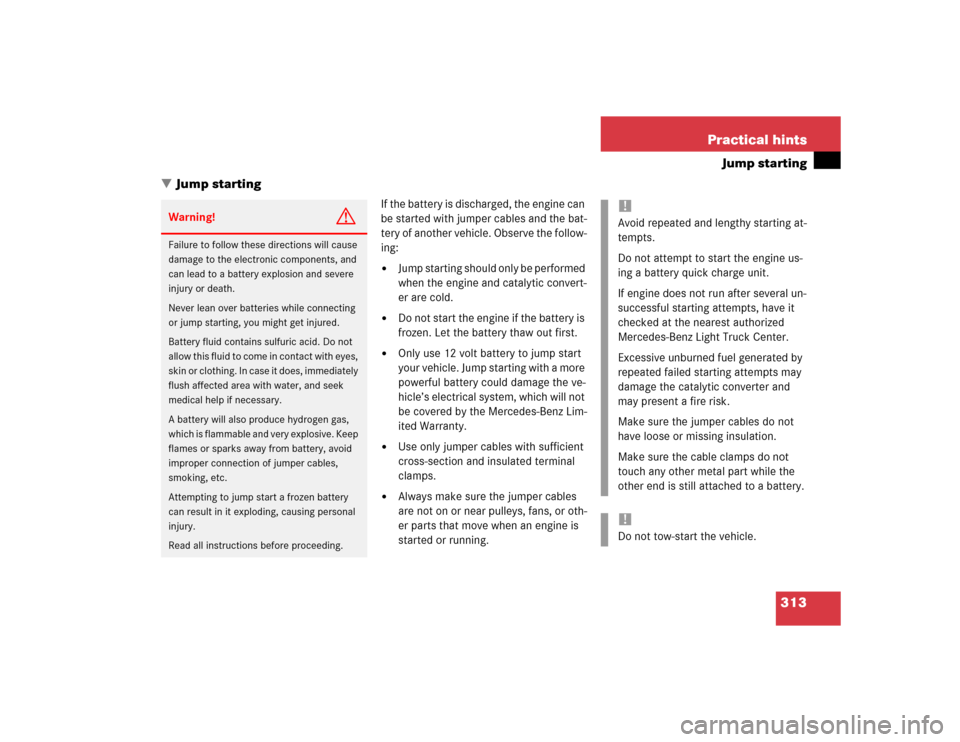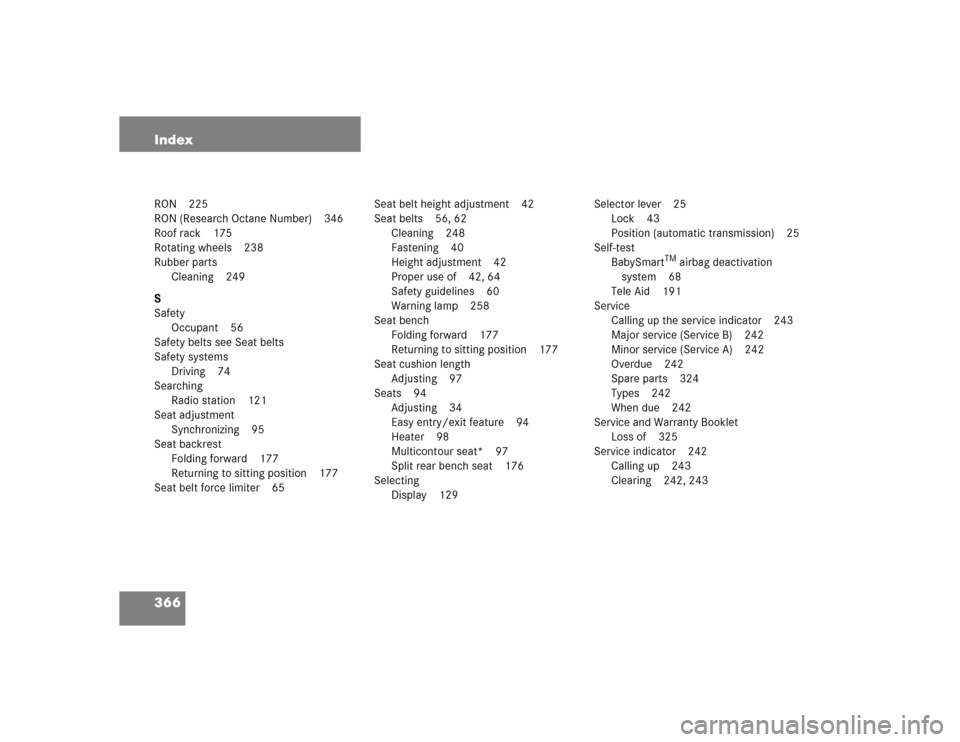Page 313 of 376

313 Practical hints
Jump starting
�Jump starting
If the battery is discharged, the engine can
be started with jumper cables and the bat-
tery of another vehicle. Observe the follow-
ing:�
Jump starting should only be performed
when the engine and catalytic convert-
er are cold.
�
Do not start the engine if the battery is
frozen. Let the battery thaw out first.
�
Only use 12 volt battery to jump start
your vehicle. Jump starting with a more
powerful battery could damage the ve-
hicle’s electrical system, which will not
be covered by the Mercedes-Benz Lim-
ited Warranty.
�
Use only jumper cables with sufficient
cross-section and insulated terminal
clamps.
�
Always make sure the jumper cables
are not on or near pulleys, fans, or oth-
er parts that move when an engine is
started or running.
Warning!
G
Failure to follow these directions will cause
damage to the electronic components, and
can lead to a battery explosion and severe
injury or death.
Never lean over batteries while connecting
or jump starting, you might get injured.
Battery fluid contains sulfuric acid. Do not
allow this fluid to come in contact with eyes,
skin or clothing. In case it does, immediately
flush affected area with water, and seek
medical help if necessary.
A battery will also produce hydrogen gas,
which is flammable and very explosive. Keep
flames or sparks away from battery, avoid
improper connection of jumper cables,
smoking, etc.
Attempting to jump start a frozen battery
can result in it exploding, causing personal
injury.
Read all instructions before proceeding.
!Avoid repeated and lengthy starting at-
tempts.
Do not attempt to start the engine us-
ing a battery quick charge unit.
If engine does not run after several un-
successful starting attempts, have it
checked at the nearest authorized
Mercedes-Benz Light Truck Center.
Excessive unburned fuel generated by
repeated failed starting attempts may
damage the catalytic converter and
may present a fire risk.
Make sure the jumper cables do not
have loose or missing insulation.
Make sure the cable clamps do not
touch any other metal part while the
other end is still attached to a battery.!Do not tow-start the vehicle.
Page 332 of 376

332 Technical dataMain dimensions, vehicle weights and ratings
�Main dimensions, vehicle weights and ratingsMain dimensionsVehicle weights and ratings
G500
G55AMG
Overall vehicle length
(inc. spare wheel)
185.6 in (4715 mm)
185.6 in (4715 mm)
Overall vehicle width
71.3 in (1811 mm)
73.4 in (1864 mm)
Overall vehicle height
77.8 in (1977 mm)
77.8 in (1977 mm)
Wheel base
112.2 in (2850 mm)
112.2 in (2850 mm)
Ground clearance
8.3 in (211 mm)
8.3 in (211 mm)
Turning radius
523.6 in (13.3 m)
523.6 in (13.3 m)
Track, front and rear
59.6 in (1515 mm)
59.1 in (1501 mm)
G500
G55AMG
Gross Vehicle Weight Rating
1
1GVWR is the maximum permissible vehicle weight. Gross Vehicle Weight (GVW) comprises weight of vehicle including fuel, tools, spare wheel, installed accessories,
passengers, cargo and trailer tongue. It must never exceed the GVWR.
6615 lbs (3000 kg)
6615 lbs (3000 kg)
Gross Axle Weight Rating, front
2
2GAWR is the maximum permissible axle weight.
3110 lbs (1410 kg)
3110 lbs (1410 kg)
Gross Axle Weight Rating, rear
2
3965 lbs (1800 kg)
3965 lbs (1800 kg)
Page 349 of 376

349 Index
A
ABS 25, 74, 343
LOW RANGE mode 75
Malfunction indicator lamp 252, 253
Messages in display 261
Warning lamp 252, 253
Accelerator position, automatic
transmission 144
Accident
In case of 50
Activating
Air conditioning (cooling) 162
Air recirculation mode 160
Anti-theft alarm system 82
Central locking (control system) 133
Defrost 160
Easy-entry/exit feature 133
ESP 81
Exterior headlamps 46
Exterior lamps 105
Exterior rear view mirror parking
position 153Hazard warning flasher 108
Headlamps 46
High beams 108
Ignition 33
Rear fog lamp 106
Rear window defroster 155
Windshield wipers 47
Adding
Coolant 233
Engine oil 231
Additional turn signals 295
Adjusting 34
Air distribution 159
Air volume 159
Backrest tilt 36
Exterior rear view mirror 38
Head restraint height 36
Head restraint height, rear seats 96
Head restraint tilt 36
Instrument cluster illumination 112Interior rear view mirror 38
Mirrors 38
Multicontour seat* 97
Seat cushion length 97
Seat cushion tilt 36
Seat fore and aft adjustment 35
Seat height 36
Seats 34
Steering column in/out 37
Steering column up/down 37
Steering wheel 37
Air conditioning (cooling)
Turning off 162
Turning on 162
Air conditioning refrigerant 335
Air distribution
Adjusting 159
Air pressure see Tire inflation pressure
Air recirculation mode 160
Activating 160
Deactivating 161
Page 366 of 376

366 IndexRON 225
RON (Research Octane Number) 346
Roof rack 175
Rotating wheels 238
Rubber parts
Cleaning 249
S
Safety
Occupant 56
Safety belts see Seat belts
Safety systems
Driving 74
Searching
Radio station 121
Seat adjustment
Synchronizing 95
Seat backrest
Folding forward 177
Returning to sitting position 177
Seat belt force limiter 65Seat belt height adjustment 42
Seat belts 56, 62
Cleaning 248
Fastening 40
Height adjustment 42
Proper use of 42, 64
Safety guidelines 60
Warning lamp 258
Seat bench
Folding forward 177
Returning to sitting position 177
Seat cushion length
Adjusting 97
Seats 94
Adjusting 34
Easy entry/exit feature 94
Heater 98
Multicontour seat* 97
Split rear bench seat 176
Selecting
Display 129Selector lever 25
Lock 43
Position (automatic transmission) 25
Self-test
BabySmart
TM airbag deactivation
system 68
Tele Aid 191
Service
Calling up the service indicator 243
Major service (Service B) 242
Minor service (Service A) 242
Overdue 242
Spare parts 324
Types 242
When due 242
Service and Warranty Booklet
Loss of 325
Service indicator 242
Calling up 243
Clearing 242, 243